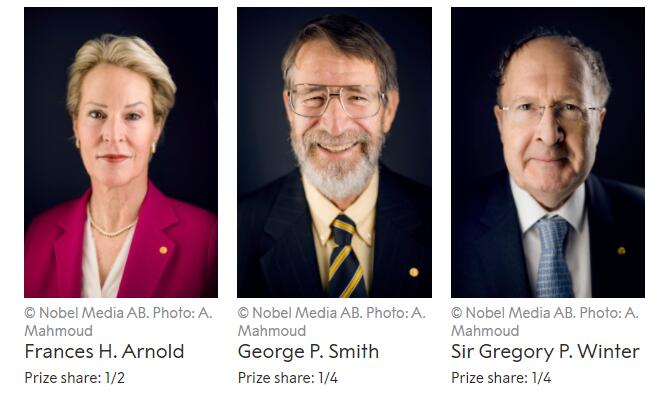 精选
精选
昨天,2024年诺贝尔化学奖公布了,David Baker、Demis Hassabis和John M.Jumper三位科学家获奖,以表彰他们在蛋白质设计和蛋白质结构预测领域作出的贡献。The Nobel Prize in Chemistry 2024 was awarded with one half to David Baker “for computational protein design” and the other half jointly to Demis Hassabis and John M. Jumper “for protein structure prediction”。该研究是生物化学课程中蛋白质结构相关章节,以及当前生物学信息学专业重要学习内容。

回顾过去10到20年中的诺贝尔化学奖的获奖内容,很多都和当前生物学的主流课程相关内容,和现在生物学内容联系也越来越紧密。回顾过去20余年的来的诺贝尔化学奖,的确是生物和化学不分家的最好体现。以下是过去20余年中诺贝尔化学奖中的生命科学元素。
2020年,诺贝尔化学奖授予法国和美国科学家Emmanuelle Charpentier、Jennifer A. Doudna,以表彰她们“开发出一种基因组编辑方法”。 The Nobel Prize in Chemistry 2020 was awarded jointly to Emmanuelle Charpentier and Jennifer A. Doudna "for the development of a method for genome editing"。基因编辑相关研究方法是基因工程课程中重要的学习内容,在当前生物学和农业科学中得到了广泛应用。

2018年诺贝尔化学获的获得者为美国科学家Frances H. Arnold, George P. Smith和英国科学家George P.Winter,他们利用进化的力量为人类造福。获奖的内容分别是研究酶的定向进化("for the directed evolution of enzymes")和研究多肽和抗体的噬菌体展示技术(for the phage display of peptides and antibodies)而获奖。该获奖内容估计生科院毕业的同学都知道,因为这是生物化学课程、酶工程和分子生物学课程讲授的主要内容之一。

2017年,瑞士科学家Jacques Dubochet, 美国科学家Joachim Frank 和英国科学家 Richard Henderson获奖,获奖成果为“研发出冷冻电镜,用于溶液中生物分子结构的高分辨率测定”。The Nobel Prize in Chemistry 2017 was awarded to Jacques Dubochet, Joachim Frank and Richard Henderson "for developing cryo-electron microscopy for the high-resolution structure determination of biomolecules in solution"。冷冻电镜获奖被戏称为“一个发给物理学家的诺贝尔化学奖,奖励他们帮助了生物学家”。

2016年,法国科学家Jean-Pierre Sauvage,英国科学家Sir J. Fraser Stoddart和荷兰科学家Bernard L. Feringa获奖,获奖成果为“分子机器的设计与合成”。The Nobel Prize in Chemistry 2016 was awarded jointly to Jean-Pierre Sauvage, Sir J. Fraser Stoddart and Bernard L. Feringa "for the design and synthesis of molecular machines"。该成果和目前十分热门的合成生物学具有一定关联。

2015,瑞典科学家Tomas Lindahl、美国科学家Paul Modrich和土耳其科学家Aziz Sancar获奖,获奖成果为“DNA修复机制研究”。The Nobel Prize in Chemistry 2015 was awarded jointly to Tomas Lindahl, Paul Modrich and Aziz Sancar "for mechanistic studies of DNA repair"。该成果是遗传学和分子生物学的重要内容之一。

2014年,美国科学家Eric Betzig、德国科学家Stefan W. Hell和美国科学家William E. Moerner获奖,获奖成果为“研制出超分辨率荧光显微镜”。The Nobel Prize in Chemistry 2014 was awarded jointly to Eric Betzig, Stefan W. Hell and William E. Moerner "for the development of super-resolved fluorescence microscopy"。该研究成果在生物学领域中得到大量应用,因而该获奖内容也是“物理学家的诺贝尔化学奖,奖励他们帮助了生物学家”。

2012年,美国科学家Robert J. Lefkowitz和Brian K. Kobilka获奖,获奖成果为“G蛋白偶联受体研究”。The Nobel Prize in Chemistry 2012 was awarded jointly to Robert J. Lefkowitz and Brian K. Kobilka "for studies of G-protein-coupled receptors"。

2009,美国科学家Venkatraman Ramakrishnan、Thomas A. Steitz和以色列科学家Ada E. Yonath获奖,获奖成果为“核糖体结构和功能研究”。The Nobel Prize in Chemistry 2009 was awarded jointly to Venkatraman Ramakrishnan, Thomas A. Steitz and Ada E.Yonath "for studies of the structure and function of the ribosome"。该内容是生物化学和分子生物学教材中的重要内容之一。

2008年,美国科学家Osamu Shimomura、Martin Chalfie和Roger Y. Tsien获奖,获奖成果为“发现并发展了绿色荧光蛋白(GFP)”。The Nobel Prize in Chemistry 2008 was awarded jointly to Osamu Shimomura, Martin Chalfie and Roger Y. Tsien "for the discovery and development of the green fluorescent protein, GFP"。该研究成果在生物学领域中被广泛应用,比如转基因载体中的荧光标记,用于转基因生物的快速筛选!

2006年,美国科学家Roger D. Kornberg获奖,获奖成果为“真核转录的分子基础”。The Nobel Prize in Chemistry 2006 was awarded to Roger D. Kornberg "for his studies of the molecular basis of eukaryotic transcription". 该内容是遗传学、生物化学和分子生物学教材中最为重要的内容。

2004年,以色列科学家Aaron Ciechanover、Avram Hershko和美国科学家Irwin Rose获奖,获奖成果为“泛素调节的蛋白质降解”。The Nobel Prize in Chemistry 2004 was awarded jointly to Aaron Ciechanover, Avram Hershko and Irwin Rose "for the discovery of ubiquitin-mediated protein degradation"。该内容是生物化学课程的重要内容之一。

2003年,美国科学家Peter Agre和Roderick MacKinnon获奖,获奖成果为“发现细胞膜通道”。The Nobel Prize in Chemistry 2003 was awarded "for discoveries concerning channels in cell membranes" Jointly with one half to Peter Agre "for the discovery of water channels" and with one halfto Roderick MacKinnon "forstructural and mechanistic studies of ion channels"。该研究成果是细胞生物学中必学内容之一。

2002年,美国科学家John B. Fenn、日本科学家Koichi Tanaka和瑞士科学家Kurt Wüthrich获奖,获奖成果为“生物大分子鉴定和结构分析方法”。The Nobel Prize in Chemistry 2002 was awarded "for the development of methods for identification and structure analyses of biological macromolecules" with one half jointly to John B. Fenn and Koichi Tanaka "for their development of soft desorption ionisation methods for mass spectrometric analyses of biological macromolecules" and the other half to Kurt Wüthrich "for his development of nuclear magnetic resonance spectroscopy for determining the three-dimensional structure of biological macromolecules in solution"。该成果和目前生物分离工程和生物化工课程内容关联十分密切。

1997年,美国科学家Paul D. Boyer、英国科学家John E. Walker和丹麦科学家Jens C. Skou获奖,获奖成果为“三磷酸腺苷的酶催化过程”。The Nobel Prize in Chemistry 1997 was divided, one half jointly to Paul D. Boyer and John E. Walker "for their elucidation of the enzymatic mechanism underlying the synthesis of adenosinetriphosphate (ATP)" and the other half to Jens C. Skou "forthe first discovery of an ion-transporting enzyme, Na+, K+ -ATPase"。该部分内容在生物化学和植物生理学教材中体现的比较多。

转载本文请联系原作者获取授权,同时请注明本文来自栗茂腾科学网博客。
链接地址:https://wap.sciencenet.cn/blog-3319332-1454630.html?mobile=1
收藏

